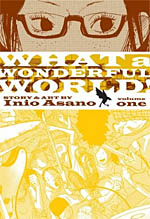 By Inio Asano
By Inio Asano
208 pages, black and white
Published by Viz
When I read Inio Asano’s Solanin at the start of the year, I remember hoping that more of Asano’s works would be translated into English; Solanin had just the right mixture of angst, aimlessness, and growing up all wrapped up in its emotional core. Clearly I wasn’t the only person wanting to see more comics by Asano; Viz is now publishing one of his earlier works, the two-volume What a Wonderful World! collection of short stories. Both volumes hit stores this week, but I was lucky enough to dip into the first half early, and it’s a joy getting to read more Asano and his stories about people whose lives are on the brink of crisis.
What a Wonderful World! Vol. 1 opens with "Quick Like a Bunny." It feels a bit like the precursor to Solanin, with Yuriko Togawa ("Toga" to her friends), a 23-year old who dropped out of college, quit her band, and has absolutely no idea what to do next with her life. As Toga starts re-evaluating what she’s doing in life, though, it’s hard to ignore the fact that the world is moving even as she continues to stand still. It’s that moment of crisis that really links the stories of What a Wonderful World!, that place in each protagonist’s life when they need to make a decision, to push everything back on track. But unlike Solanin‘s 400 pages, Toga’s decisions about her own life, her career, and her love of music is made much faster. This first story, like the best of the contributions to What a Wonderful World!, almost begs for more to be told about its characters. Asano wisely moves on here, though, saving his saga of 20-somethings and bands for Solanin.
The best story in What a Wonderful World! Vol. 1, though, is the second chapter of the book. "A Town of Many Hills" also runs over what is almost certainly familiar territory to its readers, dealing with school cliques and bullying. A story with a protagonist at the bottom of the social heap is nothing new, but Asano brings his own style to the book thanks to the nameless protagonist’s interactions with a crow that talks to her and claims to be a shinigami (or death god). "A Town of Many Hills" is in some ways the final chapter of a novel you’ve never read, with our main character unable to take any more and finally making a move the shocks and disturbs her entire class. It’s a perfect story; when the climax hits, it’s both written and drawn in such a way that it actually took my breath away for a moment. It takes what could have been a cliché moment and turns it on its head, the protagonist taking an option that no one—not her classmates, not the reader, and not the shinigami—believes possible. If you had to only read one story in What a Wonderful World! Vol. 1, this would be the one I’d recommend. It’s a textbook usage of the form of the short story, its length being part of its strength.
The rest of the stories vary in quality, although they’re all worth reading. "Wandervogel" feels like it hits some of the same notes as "Quick Like a Bunny" and its usage of the siren call of the music industry, although here the gender is at least swapped. Seeing the same basic theme revisited is also true in "White Star, Black Star" and its take on bullying, although here it’s a very different—and far more disturbing—take than "A Town of Many Hills." It and the crime-gone-wrong "The Bear from the Forest" are the two darkest stories in the book, and their bleaker takes on life help differentiate the different stories from each other. Asano also starts playing with story length as What a Wonderful World! progresses; "Sunday People" and "Mini Grammar" both work in part because of their brief natures (less than 10 pages each), hitting an emotional turning point for each of their characters and then instantly moving forward to the next selection.
Asano’s art is a beautifully delicate creation, focusing on its characters as they walk down city streets, or huddle in their spartan apartments. Because Asano’s stories so often depend on the subtle reactions of the characters as an emotional catharsis hits, there isn’t much flash or bang to the art in the book. Instead, we get those flickers of happiness or surprise that move across their faces, that sudden gritting of teeth as determination washes over their spirit. There’s one short story where the entire piece revolves around the protagonist returning home to find her boyfriend gone. There’s never any huge focusing of him always being in the same spot in their room, even though that situation is heavily implied. But when Asano draws her walking into the suddenly empty room, he’s able to bring that to life through his art. The way he frames his panel, you can almost see the gaping void where the pillows and coffee table sit. There isn’t anything out of the ordinary going on, visually, but Asano sells the scene through his craft and just how well he draws the mundane.
Each of the stories in What a Wonderful World! Vol. 1 is tentatively linked to the next by a two page sequence where the characters walk by one another, or near the setting of the next piece. To be honest, it felt unnecessary to me, because What a Wonderful World!‘s stories are already linked in terms of how they each tackle the turning points of their protagonists. This is a charming book, and I already know that I’ll be buying the second half as soon as it both books hit stores this week. It’s great to see Asano’s comics brought into English again, and here’s hoping for still more to come.
Purchase Links: Amazon.com | Powell’s Books
